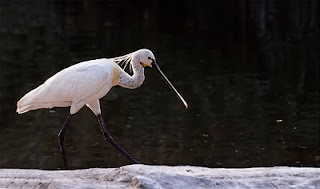
Ranganthittu Bird Sanctuary (Kannada: ರಂಗನತಿಟ್ಟು ಪಕ್ಷಿಧಾಮ) is a Bird Sanctuary in the Mandya District of the state of Karnataka in India. It is a very small sanctuary, being only 67 km². in area, and comprises six islets on the banks of the Kaveri River. Ranganthittu is located near the historic town of Srirangapatna.
History of the Park
The islets came into being when a dam across the Kaveri river was built in the 1700s. The ornithologist Dr. Salim Ali observed that the isles formed an important nesting ground for birds, and persuaded the Wodeyar kings of Mysore to declare the area a wildlife sanctuary in 1940.
Natural History of the Park
Biomes
Most of the park falls under the Riparian biome, corresponding to the Indomalayaecozone.
Flora
Riverine reed beds cover the banks of the islands, while the islands themselves are covered in broadleaf forests, with dominant species beingTerminalia arjun (Arjun tree), bamboo groves, and Pandanus trees. Eucalyptus and Acacia trees have also been planted, which might lead to long-term eradication of native species. The endemic and threatened lily Iphigenia mysorensis of the family Colchicaceae grows in the sanctuary.
Fauna
The islands are host to numerous small mammals, including Bonnet Macaque, colonies of Flying Fox and common small mammals like Common Palm Civet and Indian Gray Mongoose and the monitor lizard.
The Mugger Crocodile or Marsh Crocodile is a common inhabitant of the riverine reed beds. Breeding water birds include Painted Stork, Asian Openbill Stork, Common Spoonbill, Woolly-necked Stork, Black-headed Ibis, White Ibis, Lesser Whistling Duck, Indian Shag, Stork-billed Kingfisher and other common birds like egrets, cormorants, Oriental Darter, and herons. The Great Stone Plover, and River Tern also nest here. The park is home to a large flock of Streak-throated Swallows.

The Asian Openbill or Asian Openbill Stork, Anastomus oscitans, is a large wading bird in the stork family Ciconiidae. It is a resident breeder in tropical southern Asia from India and Sri Lanka east to Southeast Asia.
Asian Openbill Stork is a broad-winged soaring bird, which relies on moving between thermals of hot air for sustained flight. Like all storks, it flies with its neck outstretched. It is relatively small for a stork at 68 cm length. They breed near inland wetlands and build stick nest in trees, typically laying 2-6 eggs.
Breeding adults are all white except for the black wing flight feathers, red legs and dull yellow-grey bill. The mandibles do not meet except at the tip, and this gives rise to the species' name. Non-breeding adults have the white of the plumage replaced by off-white. Young birds have brown tinge to the plumage.

The Asian Openbill Stork, like most of its relatives, walks slowly and steadily on the ground, feeding on molluscs,fish, frogs and large insects.
Pied Kingfisher : The Pied Kingfisher (Ceryle rudis) is a water kingfisher and is found widely distributed across Africa and Asia. Their black and white plumage, crest and the habit of hovering over clear lakes and rivers before diving for fish makes it distinctive.This kingfisher is about 17cm long and is white with a black mask, a white supercilium and black breast bands.
The crest is neat and the upperparts are barred in black. Several subspecies are recognized within the broad distribution. The nominate race is found in sub-Saharan Africa, extending into West Asia. A former subspecies syriaca is considered as merely a larger northern bird of the nominate species . Subspecies leucomelanura is found from Afghanistan east into India, Sri Lanka, Thailand and Laos. The subspecies travancoreensis of the Western Ghats is darker with the white reduced. Subspecies C. r. insignis is found in Hainan and southeastern China and has a much larger bill. Males have a narrow second breast-band while females have a single broken breast band
This was a very shy bird and according to the boatman, this bird was not matured. Hence it did not allow us to go near it.
Great Stone Plover (great thick knee) : The Great Stone-curlew or Great Thick-knee (Esacus recurvirostris) is a large wader which is a resident breeder in tropical southern Asia from Pakistan and the Republic of India, Sri Lanka into South-east Asia.
This species prefers gravel banks along rivers or large lakes, and also beaches. A single egg is laid in a bare scrape on the open shingle.
It is mainly nocturnal or crepuscular like other stone-curlews, but can frequently be seen foraging during the day, moving slowly and deliberately, with occasional short runs. It tends to be wary and flies off into the distance ahead of the observer, employing powerful, rather stiff wingbeats.
The Great Thick-knee is a large wader at 49–55 cm, and has a massive 7 cm upturned bill. It has unstreaked grey-brown upperparts and breast, with rest of the underparts whitish. The face has a striking black and white pattern, and the bill is black with a yellow base. The eyes are bright yellow and the legs a duller greenish-yellow.
In flight, the Great Thick-knee shows black and white flight feathers on the upperwing, and a mainly white underwing. Sexes are similar, but young birds are slightly paler than adults.

The call is a wailing whistle, given mainly at night, as with other birds in this family. The Great Thick-knee eats crabs, large insects, and other animal prey
Night Heron : The night herons are medium-sized herons in the genera Nycticorax, Nyctanassa and Gorsachius.
The genus name Nycticorax derives from the Greek for “night raven” and refers to the largely nocturnal feeding habits of this group of birds, and the croaking crow-like call of the best known species, the Black-crowned Night Heron.
Adults are short-necked, short-legged and stout herons with a primarily brown or grey plumage, and, in most, a black crown. Young birds are brown, flecked with white. At least some of the extinct Mascarenes taxa appear to have retained this juvenile plumage in adult birds.
Night herons nest alone or in colonies on platforms of sticks in a group of trees, or on the ground in protected locations such as islands or reedbeds. 3-8 eggs are laid.
Night herons stand still at the water's edge, and wait to ambush prey, mainly at night. They primarily eat small fish, crustaceans, frogs, aquaticinsects, and small mammals. During the day they rest in trees or bushes.
There are seven extant species. The genus Nycticorax has suffered more than any other ciconiiform genus from extinction, mainly because of their capability to colonize small, predator-free oceanic islands, and a tendency to evolve towards flightlessness.
After a nice morning boat ride at Ranganthittu , we went to Mysore which is around 17 kms from the bird sanctuary. As all of us were tired and hungry , the famous Dosas of Mylary Hotel were waiting for us.
The darters or snakebirds are mainly tropical waterbirds in the family Anhingidae. There are four living species, three of which are very common and widespread while the fourth is rarer and classified as near-threatened by the IUCN.

Then , we moved to the aviary where we saw Indian Peacock, Saurus cranes, Jungle fowls , Shovellers , Pheasant etc., (This was just because, one of our members had never been there before)
Lady Amherst Pheasant : " Though I do not encourage caging of animals, I just wanted to show you the colors of this beautiful bird ".
Range: Southwestern China & northern Burma. Has been introduced and is breeding locally into parts of Great Britain. Attempted introductions have taken place throughout the world, including New Zealand and Hawaii. Birds may also be seen in a semi-feral state in the US, mostly escapes from aviaries or purposely released. It is doubtful there are any breeding populations here.
Habitat: Forested areas and bamboo thickets.
Description: Unmistakable and well known in aviculture, however, many captive birds may show signs of breeding with the related Golden.
Avicultural Data
Status in Aviculture: Debated, pure Lady Amherst are considered rare, but a census of breeders show this to be a very common aviary bird.
Breeding Season: Varied, depending on climate, but usually begins in May. I have had aviary birds lay as early as January.
Breeding Age: While the adult plumage is not attained until the second year, first years birds are often fertile.
Clutch Size: 6-12
Incubation Period: 23-24 days.
Oriental Magpie Robin : The Oriental Magpie Robin (Copsychus saularis) is a small passerine bird that was formerly classed as a member of the thrush family Turdidae, but is now considered anOld World flycatcher.
They are distinctive black and white birds with a long tail that is held upright as they forage on the ground or perch conspicuously. Distributed in many parts of tropical South and Southeast Asia, they are common birds in urban gardens as well as forests. They are particularly well known for their songs and were once
In recent years: the Great Egret, for example, has been classified as a member of eitherCasmerodius, Egretta or Ardea.
In the 19th and early part of the 20th century, some of the world's egret species were endangered by relentless hunting, since hat makers in Europe and the United States demanded massive numbers of egret plumes and breeding birds were killed in locations all around the world.

Several Egretta species, including the Eastern Reef Egret, the Reddish Egret and the Western Reef Egret have two distinct colours, one of which is entirely white. Little Blue Heron has all-white juvenile plumage.

Pelican : A pelican is a large water bird with a distinctive pouch under the beak, belonging to the birdfamily Pelecanidae.
Along with the darters, cormorants, gannets, boobies, frigatebirds, and tropicbirds, pelicans make up the order Pelecaniformes. Modern pelicans, of which there are eight species, are found on all continents except Antarctica.
Spoonbill : Spoonbills are a group of large, long-legged wading birds in the family Threskiornithidae, which also includes the Ibises. All have large, flat, spatulate bills and feed by wading through shallow water, sweeping the partly-opened bill from side to side. The moment any small aquatic creature touches the inside of the bill—an insect,crustacean, or tiny fish—it is snapped shut.
Spoonbills generally prefer fresh water to salt but are found in both environments. They need to feed many hours each day.
Spoonbills are monogamous, but, so far as is known, only for one season at a time. Most species nest intrees or reed-beds, often with ibises or herons. The male gathers nesting material—mostly sticks and reeds, sometimes taken from an old nest—the female weaves it into a large, shallow bowl or platform which varies in its shape and structural integrity according to species.
The female lays a clutch of about 3 smooth, oval, white eggs and both parents incubate; chicks hatch one at a time rather than all together. The newly-hatched young are blind and cannot care for themselves immediately; both parents feed them by partial regurgitation. Chicks' bills are short and straight, and only gain the characteristic spoonbill shape as they mature. Their feeding continues for a few weeks longer after the family leaves the nest. The primary cause of brood failure appears not to be predation but starvation.
Thank you everyone for making this trip successful













